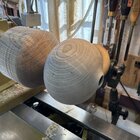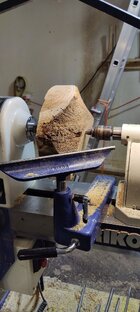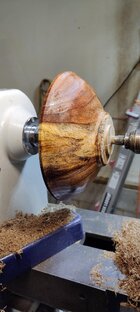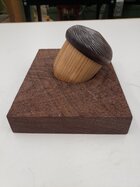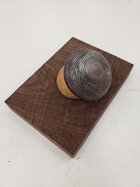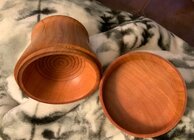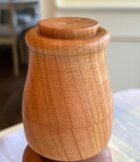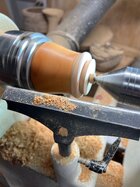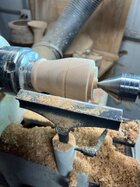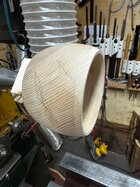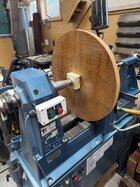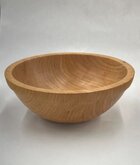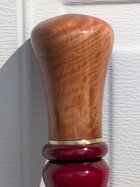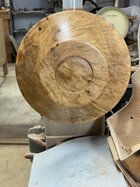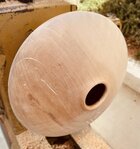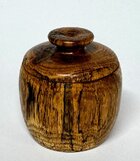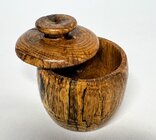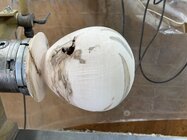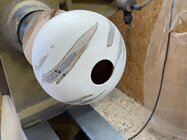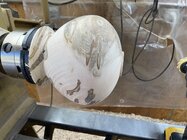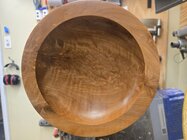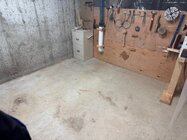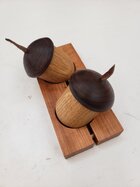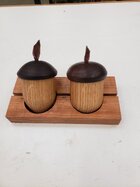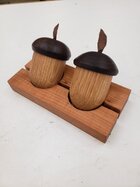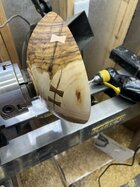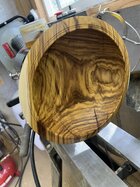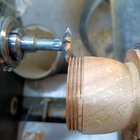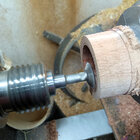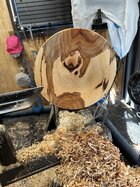-
April 2025 Turning Challenge: Turn an Egg! (click here for details) -
Congratulations to Kelly Shaw winner of the March 2025 Turning Challenge (click here for details) -
Congratulations to Guillaume Fontaine for "Nebules" being selected as Turning of the Week for April 6, 2025 (click here for details) -
Welcome new registering member. Your username must be your real First and Last name (for example: John Doe). "Screen names" and "handles" are not allowed and your registration will be deleted if you don't use your real name. Also, do not use all caps nor all lower case.
You are using an out of date browser. It may not display this or other websites correctly.
You should upgrade or use an alternative browser.
You should upgrade or use an alternative browser.
What’s on your lathe?
- Thread starter Rusty Nesmith
- Start date
I'm guessing that with Pau Santo, the interlocked grain combined with its great density has something to do with the difficulties I was having with this wood. Since you can't pick and choose the best direction for cutting the end grain in a cross-grain bowl, the goal of achieving "the perfect cut" becomes an almost impossible task.....and, if there is any tearout at all, the sanding is just as frustratingly difficult.
=o=
I've run into a few pieces with the interlocking grain. You're right, they are a PIA to turn. Mostly I've encountered that when doing spindle work and smoothing with a skew when the chip takes a nose dive.
It's still a perfect form like all of your work.
Last time I turned mimosa/silk tree, I got congested and started itching.... Nevermore!
robo hippy
robo hippy
Last time I turned mimosa/silk tree, I got congested and started itching.... Nevermore!
robo hippy
I wore a mask the entire time just in case.
Since Robert posted his acorn box in the Gallery I'll post a picture of my effort here (not gallery material).Turned my first acorn box had some ash and black walnut laying around
Made jamb chucks for both in order to finish them.View attachment 74375
Box body is White Oak with a Black Walnut lid (cap). Lid is spirally textured. Polymerized Tung Oil finish with silver metallic wax on the textured area. The metallic wax is less apparent in the picture. Base is the end of a circular sawn Black Walnut board I left rough on the surface the acorn is set in. This was a fun little project (Thanks for the inspiration Robert); I think I might explore this idea further.
Cheers.
Barry W. Larson
Calgary, Alberta, Canada eh!
Attachments
Dry, hard ash bowl on one lathe - two cracks filled with CA. Will likely do two bird-in-flight pewas. Arthritis acting up so taking a break and glued up two pieces of cherry for a book matched, rimmed platter on the other lathe.
Attachments
The little bowl is a piece of mulberry 6 x 1.75 turned on my big lathe just because I hadn't made a bowl for a couple of weeks. And the other is a walking stick knob that I really liked the curl turned on my little lathe. Maybe red iron bark. Or FOS wood. (found on shelf)
Attachments
Nice job! I am flatteredSince Robert posted his acorn box in the Gallery I'll post a picture of my effort here (not gallery material).
Box body is White Oak with a Black Walnut lid (cap). Lid is spirally textured. Polymerized Tung Oil finish with silver metallic wax on the textured area. The metallic wax is less apparent in the picture. Base is the end of a circular sawn Black Walnut board I left rough on the surface the acorn is set in. This was a fun little project (Thanks for the inspiration Robert); I think I might explore this idea further.
Cheers.
Barry W. Larson
Calgary, Alberta, Canada eh!
gorgeous wood and bowl-I'd love to get a hold of some of that wood! It seems quite expensive when you can find it.
Beautiful, Gary! I'm finishing the bottom on a nice curly maple little platter/candy bowl I guess, and considering almost that identical finishing regimen. I have used pretty much every oil-based finish over Yorkshire Grit. I assume no issues spraying lacquer over it?Still on the lathe, waiting to finish the topside. Labeled as cherry burl. Sanded to 400 grit, shellac sealer, Yorkshire Grit then spray lacquer.
View attachment 74509
What species, Phil-I imagine if it was Fraser Fir it would smell like Christmas too! (Incidentally, I was at GotWood in Donalds, SC with Tim Tucker yesterday picking up some wood for our club classes as well as some for our personal use of course. Anyway, Brad had a stack of camphor burl squares that were stunning to look at, and smelled like Vicks VapoRub. I had never smelled it before. He wanted more for them than I was prepared to spend, but next time I definitely want a square or two-got to sell some stuff!).
Interesting piece of wood. It appears to be ring porous with extra long medullary rays, sort of like something in the white oak family of woods.
- Joined
- Nov 27, 2021
- Messages
- 162
- Likes
- 670
- Location
- Silver Spring, MD
- Website
- www.transpirationturning.com
Not sure on species. Got it from a sister who had it in her yard ready for burning.What species, Phil-I imagine if it was Fraser Fir it would smell like Christmas too! (Incidentally, I was at GotWood in Donalds, SC with Tim Tucker yesterday picking up some wood for our club classes as well as some for our personal use of course. Anyway, Brad had a stack of camphor burl squares that were stunning to look at, and smelled like Vicks VapoRub. I had never smelled it before. He wanted more for them than I was prepared to spend, but next time I definitely want a square or two-got to sell some stuff!).
Had the full helmet and air handlers running. Can't smell anything with all that going.
I would love to stop there! My wallet wouldn't! Bad enough what I get over the internet! Lol!
Your forms are looking great! How’s the hollowing going? That was my toughest part. Also do you hollow by hand or use some type of hollowing system?Turned a couple of small hollow forms today. I finished the bottom on one, wrapped the other one in plastic and will finish the bottom on it tomorrow. They say practice makes perfect and I need the practice on hollow forms
View attachment 74519
View attachment 74518
View attachment 74517
I still don't have any idea what kind of wood this is. Anyone have a suggestion of what it is?
The first picture of the inside of the bowl it has been wiped with mineral spirits.
View attachment 74235
View attachment 74236
James, to my eye, it looks similar to honey locust. Could it be?
James, I just saw this post.
Do you have a UV light/flashlight? (I keep several here for wood ID, checking eggs for incubation reasons and for some other things.)
If you do, and still have a offcut or an unfinished piece of that wood around, try looking at in a darkened space with the UV. Locust and Honey Locust are species that fluoresce bright green under UV.
Here’s an example. On the right is a block of Locust, room light at the top and UV light at the bottom.
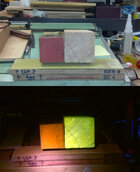
The UV light is especially helpful to distinguish locust from other species (such as Mulberry and Osage) that can sometimes look similar on the end grain.
BTW, you can distinguish Honey Locust from Black Locust (and some other species) by looking at the pores in an engrain sample with a magnifier - the pores in Black Locust are packed with tyloses (like white oak) while those of Honey Locust are open (like red oak).
You can also send a small sample to the USDA Forest Products Lab for a free ID, details at the bottom of this Wood Database article:
Wood Identification Guide | The Wood Database
I sent a sample once as a test and a double check on an ID I did for someone else. Wood ID is just a hobby for me. The gov lab agreed with my ID. (whew!
JKJ
It’s going fairly good. This was some 8” chunks of maple I had and thought they would be good practice, going to turn one more today. I use the Lyle Jamison system and it works good, just have to battle the laser going in and out. I really don’t want to use a camera. I’m going to search for a better laser to attach. I also need to get a couple of Trent Bosch cutter/arm to try on it.Your forms are looking great! How’s the hollowing going? That was my toughest part. Also do you hollow by hand or use some type of hollowing system?
I have a goose neck Sorby I have used in the past and think I will start with it on larger HF’s to remove some bulk material on the inside then switch to Lyles system.
Still looking at the ones completed to decide if I want to pierce or carve.
Do you hollow by hand or system?
Last edited:
I've run into a few pieces with the interlocking grain. You're right, they are a PIA to turn. Mostly I've encountered that when doing spindle work and smoothing with a skew when the chip takes a nose dive.
It's still a perfect form like all of your work.
There are a number of species, both exotic and US domestic, with interlocked grain - elm is one.
The Wood Database web site describes some issues with interlocked and the related spiral grain, succinctly:
“… can present challenges when machining, and may result in tearout.” Ha!
This has some good info: (hobbithouseinc.com is one of my favorite wood reference sites, along with the Wood Database)
JKJ
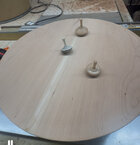
That piece of cherry is now a 19 5/8” diameter platter with a slightly raised edge for an interactive piece for the art exhibit I have coming up in May. I plan to make about six to eight tops out of different species of wood, and behind the platter will be a rack to hold the tops, made out of the same species of wood with the name and a winter silhouette of each of the tree species lasered into the rack.
View attachment 74528
That piece of cherry is now a 19 5/8” diameter platter with a slightly raised edge for an interactive piece for the art exhibit I have coming up in May. I plan to make about six to eight tops out of different species of wood, and behind the platter will be a rack to hold the tops, made out of the same species of wood with the name and a winter silhouette of each of the tree species lasered into the rack.
What a nice idea. (I organized a top-spinning contest at a club meeting once and have had some impromptu spinning contests at social events - top wars are fun with a very shallow dished surface!)
The rack should be nice, but with an interactive piece how will the tops end up back in the right spots?
BTW, I love making finger tops and people love getting them. I’ve made many 100s over the years and given away most of them. Also, for those who don’t want to turn a surface a metal or wood cake stand can work well - those often have raised edges on the circumference. We have one like that made of stainless steel, great for spinning tops!)
JKJ
Last edited:
None so far. I make a point of buffing it off really well before spraying.gorgeous wood and bowl-I'd love to get a hold of some of that wood! It seems quite expensive when you can find it.
Beautiful, Gary! I'm finishing the bottom on a nice curly maple little platter/candy bowl I guess, and considering almost that identical finishing regimen. I have used pretty much every oil-based finish over Yorkshire Grit. I assume no issues spraying lacquer over it?
The signage will encourage them to spin a top or two, and then replace them in the rack once done so they are ready for the next person. (I plan to make a batch of each on the off-chance that some walk). The title of the piece is “Tree Tops”What a nice idea. (I organized a top-spinning contest at a club meeting once and have had some impromptu spinning contests at social events - top wars are fun with a very shallow dished surface!)
The rack should be nice, but with an interactive piece how will the tops end up back in the right spots?
BTW, I love making finger tops and people love getting them. I’ve made many 100s over the years and given away most of them. Also, for those who don’t want to turn a surface a metal or wood cake stand can work well - those often have raised edges on the circumference. We have one like that made of stainless steel, great for spinning tops!)
JKJ
I don't have a UV light but, I will get one. Thanks for the information.Do you have a UV light/flashlight? (I keep several here for wood ID, checking eggs for incubation reasons and for some other things.)
Unfortunately that bowl is all of that wood I have. Which is unusual, I would think I'd have the other half of the log.
Gary, that piece of cherry burl looks a lot like myrtle/bay laurel. You don't get much of that way down south though....
robo hippy
robo hippy
Tom Gall
TOTW Team
Another item that works well - I have glass plate (turntable) from an old microwave. Only downside - if large (like mine) it is a little heavy.Also, for those who don’t want to turn a surface a metal or wood cake stand can work well - those often have raised edges on the circumference. We have one like that made of stainless steel, great for spinning tops!)
Continuing on with the idea started by Robert Lindstadt, another two acorn boxes in White Oak with Walnut tops. This time I "dressed" up the tops bit with some leather "stems" and made a more refined (well in MHO anyway) base out of cherry with brass pins. Finished with polymerized tung oil.
Cheers.
Barry W. Larson
Calgary,Alberta, Canada eh!
Cheers.
Barry W. Larson
Calgary,Alberta, Canada eh!
Attachments
I don't have a UV light but, I will get one.
I’ve bought several from Amazon. They are NOT all the same as far as function.
You want a 365nm light, some of the cheaper ones are too close to the visible light frequencies and/or use cheap LEDs that put out too much white light. These are pretty much worthless, IMO.
I’m happy with this one - bought it five years ago (for the same price, $25)
This is my favorite, more powerful and has other light modes, but it was about $100 nine years ago, but no longer available. It’s bulkier. I like the inclusion of the white lite mode to get me to a search area when I am using it outdoors in the high grass and brush at night (hunting for guinea nests and certain insects and garden pests).
Certainly not needed for wood ID.
I haven’t researched any recently. Unfortunately, I wouldn’t be able to tell if any of the really cheap lights are any good without buying one and comparing it to a good UV light. At one time I bought two cheap lights and one was good and the other, later, from the same source, was worthless.
I might take a chance on this one:
If interested in the subject, perhaps take a look at these Wood Database articles:
Wood Identification Guide
Wood Identification Guide | The Wood Database
And specifically on fluorescence (just one of the useful tools)
Fluorescence: A Secret Weapon in Wood Identification | The Wood Database
Also, I rely on this book as a guide to looking at the structure in end grain:
Identifying Wood by R. Bruce Hoadley
The Hoadley book, or more correctly, the brief intro to wood ID in Hoadley’s other book, Understanding Wood, is what got me interested ID as a hobby. BTW, in my opinion anyone who works with wood, especially green wood, can benefit from his Understanding Wood book. Hoadley is both a craftsman and a wood technologist and his perspective is far more appropriate for those of us who turn and process logs than some of the far more complex technical books I have. (I actually bought two of each book - I occasionally loan the Understanding Wood book out and I used the first Identifying Wood book so much the pages are all falling out!)
The book Understanding Wood:
JKJ
Last edited:
Thanks for all the information John!
I like turning hickory and you’re right, it’s hard to get a clean piece.The recent tornadoes in Mississippi got close. We did have some high winds where I am at. An 18” hickory came down in a hollow. This is one of 9 bowls that I got out of the trunk. It’s hard to get a clean bowl out of hickory here as there are lots of knots. Hope this one holds together!
View attachment 74540

